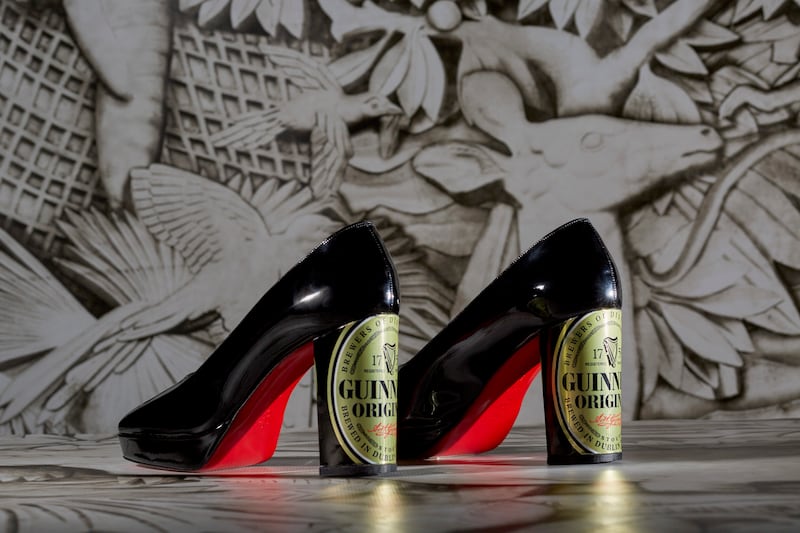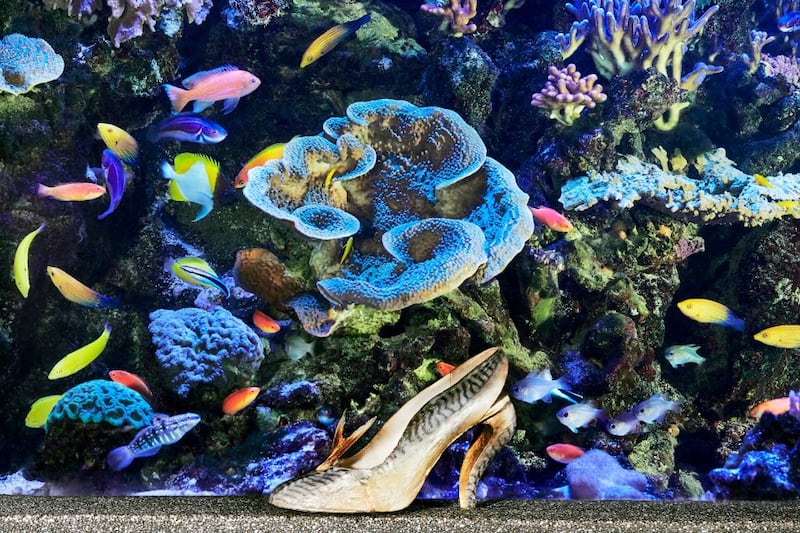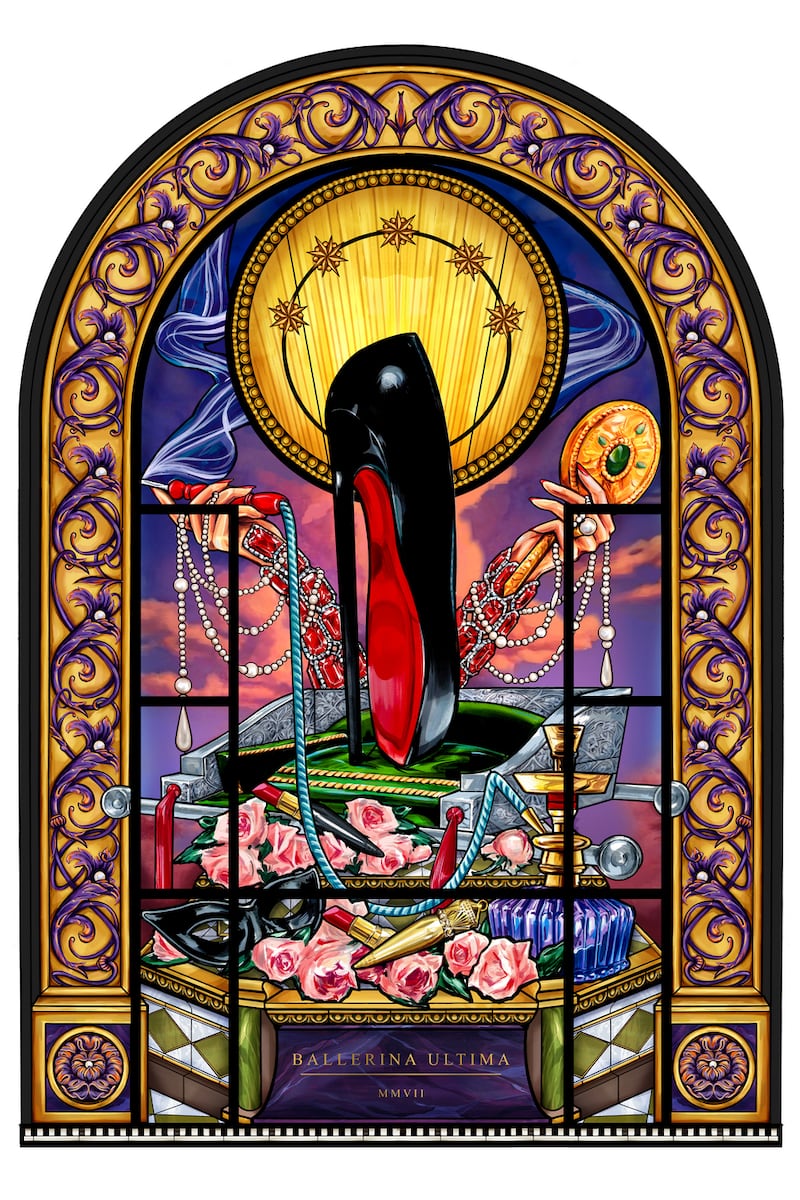When Christian Louboutin was a small boy growing up in the 12th district of Paris, he was intimidated by the columned façade and enormous rooms of the Palais de la Porte Dorée. The Art Deco monument had been built for the 1931 Exposition Coloniale and was still a museum dedicated to former French colonies.
Louboutin, who was born in 1964, visited often. His older sister Claudine held his hand. Later, he began exploring the museum’s treasures on his own. Today Louboutin, the world’s most famous shoe designer, is helping to restore the Palais, which now houses the French Museum of Immigration. A retrospective of Louboutin’s design work, titled L’Exhibitioniste, will run there until January 3rd, 2021.
Louboutin meets me in the cavernous foyer for a two-hour plunge into the origins of his creativity. We begin with the salons built for Marshal Hubert Lyautey, the flamboyant colonialist writer and military officer who oversaw the 1931 exhibition, and Paul Reynaud, who was then minister for French colonies.
Lyautey’s office was made by the Art Deco designer Eugène Printz, who crafted furniture from rare, stripey palm wood. Jacques-Émile Ruhlmann, another great Art Deco designer, created urns, leather club chairs and a mahogany table topped with the skin of a stingray in Reynaud’s office.

With the exception of Printz and Ruhlmann, most designers of the Palais were young and unknown. They include Jean Prouvé, who created the wrought iron front gate with a pyramid motif. “The designers who contributed to the construction of this museum around 1930 would become the best known designers of the 1950s [when Art Deco enjoyed a revival],” says Louboutin.
“Art Deco was a period of great alignment between architecture and design,” Louboutin continues. “And it was very, very well made. It was before the introduction of plastic and PVC, so all the materials are noble. Every aspect was included, from lettering, to furniture to architecture. There is an all-encompassing language.”

Louboutin’s childhood love for the Palais and its contents prefigured his career. He made his first shoe, titled The Mackerel, in 1987. The fish-skin patterned leather was inspired directly by the iridescent fish he’d seen swimming in the Palais’ basement aquarium. The French word for mackerel is slang for pimp, adding the playful sexual innuendo typical of much of Louboutin’s work.
Statues from the South Pacific in the giant salle des fêtes, wall murals of Africa and French Polynesia combined with Louboutin’s fondness for Tintin adventure comics to endow him with an enduring passion for travel.
For some reason I had a natural bond with Egypt. I was very, very happy to know I was connected properly to it
For his exhibition, Louboutin employed French stained-glass window makers, metal workers and creators of wax roses in Seville, and Jewish Cordoba leather artisans whose ancestors had fled the Spanish Inquisition. He sought out embroiderers in India, craftsmen in Bhutan and a video artist from New Zealand.
Louboutin's French father, Roger, was a quiet cabinetmaker who designed railway car maquettes for the French company SNCF. His mother, Irène, was a fun-loving housewife.
Six years ago, after both parents had died, Louboutin’s sister told him that his biological father was in fact an Egyptian worker who had an affair with his mother.
"I was not really surprised," Louboutin says. "For some reason I had a natural bond with Egypt. I have a house there. I have a boat there, on the Nile. I always loved Egypt. I was very, very happy to know I was connected properly to it."

In the 1980s, Louboutin received an invitation to a dinner in a protected Paris mansion. On the invitation card was a high-heeled shoe, crossed out with a red X. “I looked at that sketch and I thought, ‘My God, this is the drawing that I saw in the museum!’ It clicked. I had remembered without remembering. It was in my subconscious. It was my rosebud, like Citizen Kane’s sled in the Orson Welles movie.”
The Palais de la Porte Dorée had forbidden women from wearing high heels so they would not damage its mosaic and parquet floors. That sign inspired Louboutin’s most successful shoe, a black pump with a stiletto heel and a red sole. True to character, he christened it Pigalle, after the Paris red light district.
After his mother died, Louboutin’s sister found drawings she had saved from his childhood. A sketch closely resembling the Pigalle shoe was marked “Christian 12 or 13”.
Louboutin had the idea for the red sole while watching a model varnish her fingernails in 1992. Every shoe he has designed since, including flats and sneakers, has had a red sole. In 2018, the EU Court of Justice protected his exclusive use of the red sole as a signature and copyright.
I would sometimes sit alone in a cafe and listen to people.
Louboutin says his creativity is rooted in show business rather than fashion. A turbulent teenager, he was thrown out of three lycées, one next door to the Palais de la Porte Dorée. He went to the Palace night club almost every night. At age 17, he got a job as an assistant at the Folies Bergère music hall where he designed shoes for dancers in his spare time.
Louboutin learned the fundamentals of shoe design working for the high end shoe manufacturer Charles Jourdan. He often discussed inspiration with his subsequent mentor, Roger Vivier, who created shoes for, among others, Christian Dior and the Queen of England.
“I told Roger that conversation was a great source of inspiration to me. I would sometimes sit alone in a cafe and listen to people.”
At a dinner party in the early 1990s, the conversation turned to sustainable fashion. Louboutin's friend Daphne Guinness, the Anglo-Irish socialite and fashion designer, gave him advice. "She said, 'If you do cans, you should concentrate on Guinness cans. They are beautiful because they are black and gold'." The result was an elegant black pump with a Guinness beer can melded to the heel.
Louboutin could not find Guinness beer cans in Paris, so he travelled to London. After the purchase, he was horrified to find the cans had been stamped with the words “25 per cent extra” in green. “I had to go to pubs all over London searching for Guinness cans without green paint,” he laughs.
Another Irish-inspired shoe, made from silver macramé, is called Dublin Lainey, for Irish designer Lainey Keogh.
Louboutin is an inveterate collector of objets d’art, sculpture and painting. The last section of his exhibition at the Palais de la Porte Dorée is his musée imaginaire, a term invented by the writer and statesman André Malraux to describe the artworks that inspire a person, his or her ideal museum.

Louboutin's musée imaginaire spans centuries and continents. The exhibits are either from his private collection or borrowed from museums. They include a curved Oscar Niemeyer sofa, a sculpture by Damien Hirst, paintings by the British and US pop artists Allen Jones and Andy Warhol, Japanese and Turkish ceramics, a Gandhara sculpture blending ancient Greek and Buddhist influence, Marlene Dietrich's canary yellow feather cape, and a wave machine which Louboutin first saw on the Champs-Élysées in the 1970s, and which now graces his living room near the Place Vendôme.
Louboutin's collection of stuffed animals – not plush toys but animals preserved by a taxidermist – is kept in his homes in Paris and Portugal. His treasures include a giant ant-eater, several tigers, a cougar and many birds. He also collects American Indian dolls, crystals and gemstones, furniture "and unfortunately, houses," he laughs.
Why unfortunately?
“Because it’s a very expensive and time-consuming collection,” Louboutin replies. “It’s not like you buy a house and it just takes care of itself.”
He brought a pavilion with three arches from India and used Portuguese tiles to decorate the swimming pool at his home in the Alentejo region of Portugal. His 17th century, typically Levantine home in Aleppo was severely damaged in the Syrian civil war. He also enjoys the house he built in Luxor, southern Egypt, his Paris apartment with views over the rooftops, and another apartment in Rio de Janeiro.
Louboutin often designs his collections at the 14th-century white stone commandry in Vendée, western France, where he oversaw the planting of intricate French gardens. It is owned by his oldest friend and business partner.
That makes “only” six homes, I note. “It’s enough,” Louboutin replies.
Louboutin cannot resist combing flea markets, art and antique dealers for more treasures. Aren’t his homes cluttered? I ask. “If you love it, it’s never too much,” he laughs. “I don’t need to have more, but I can always find room for something I like.”

















